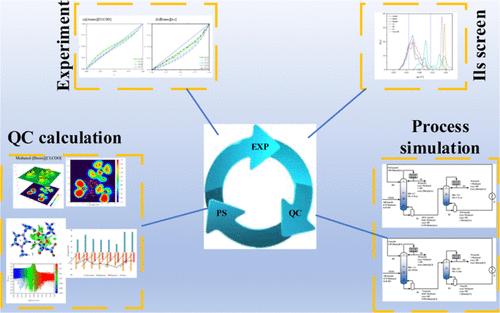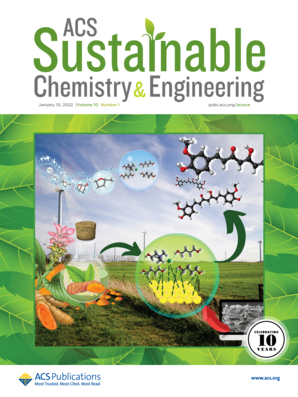Mechanism Analysis and Process Optimization for Extraction Distillation of Alcohol-Ester Azeotrope Using Ionic Liquid
IF 7.1
1区 化学
Q1 CHEMISTRY, MULTIDISCIPLINARY
引用次数: 0
Abstract
In propyl propionate production, methanol-methyl propionate azeotropes form at the column top, complicating conventional distillation separation. This work explores the process of extraction distillation for separating methanol-methyl propionate azeotropes using ionic liquids (ILs) from three aspects: molecular structure information, separation feasibility, and clean process design and optimization. In terms of molecular structure information, the separation ability of 27 cations and 28 anions for methanol-methyl propionate azeotropes is investigated using density functional theory, evaluating the value size, bonding type, and strength both quantitatively and qualitatively. In terms of separation feasibility, COSMOthermX software predicts the vapor–liquid equilibrium data of methanol-methyl propionate-ILs at 101.3 kPa, exploring the effects of IL concentration and type on alcohol/ester azeotrope separation, at the same time, the prediction results and performance were verified by experiments. In terms of process design and optimization, simulation processes for using ILs to separate alcohol/ester azeotropes have been established. The final product purity reaches over 99.99%, with a maximum reduction of 16.08% and 33.84% in total annual costs and gas emissions.

使用离子液体进行醇酯共沸物萃取蒸馏的机理分析和工艺优化
在丙酸丙酯生产过程中,甲醇-丙酸甲酯共沸物会在塔顶形成,使传统的蒸馏分离变得复杂。本研究从分子结构信息、分离可行性和清洁工艺设计与优化三个方面探讨了利用离子液体(ILs)萃取蒸馏分离甲醇-丙酸甲酯共沸物的工艺。在分子结构信息方面,利用密度泛函理论研究了 27 种阳离子和 28 种阴离子对甲醇-丙酸甲酯共沸物的分离能力,定量和定性地评估了其数值大小、键合类型和强度。在分离可行性方面,COSMOthermX 软件预测了甲醇-丙酸甲酯-ILs 在 101.3 kPa 下的汽液平衡数据,探讨了 IL 浓度和类型对醇酯共沸物分离的影响,同时通过实验验证了预测结果和性能。在工艺设计和优化方面,建立了利用 IL 分离醇/酯共沸物的模拟工艺。最终产品纯度达到 99.99% 以上,年总成本和气体排放量最大分别降低了 16.08% 和 33.84%。
本文章由计算机程序翻译,如有差异,请以英文原文为准。
求助全文
约1分钟内获得全文
求助全文
来源期刊

ACS Sustainable Chemistry & Engineering
CHEMISTRY, MULTIDISCIPLINARY-ENGINEERING, CHEMICAL
CiteScore
13.80
自引率
4.80%
发文量
1470
审稿时长
1.7 months
期刊介绍:
ACS Sustainable Chemistry & Engineering is a prestigious weekly peer-reviewed scientific journal published by the American Chemical Society. Dedicated to advancing the principles of green chemistry and green engineering, it covers a wide array of research topics including green chemistry, green engineering, biomass, alternative energy, and life cycle assessment.
The journal welcomes submissions in various formats, including Letters, Articles, Features, and Perspectives (Reviews), that address the challenges of sustainability in the chemical enterprise and contribute to the advancement of sustainable practices. Join us in shaping the future of sustainable chemistry and engineering.
 求助内容:
求助内容: 应助结果提醒方式:
应助结果提醒方式:


